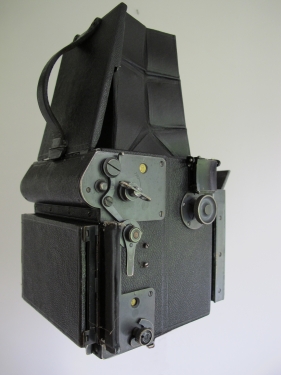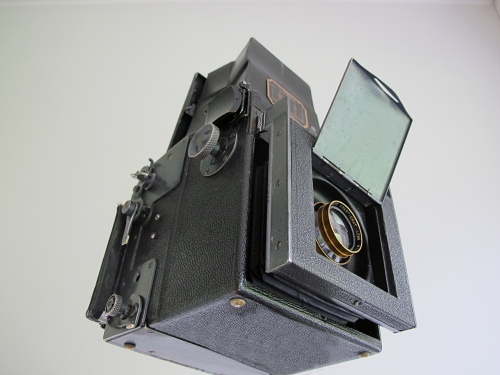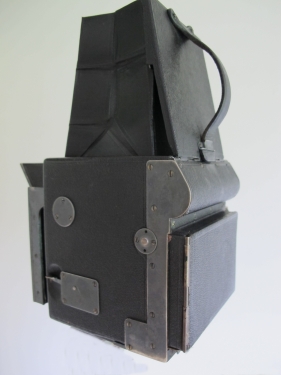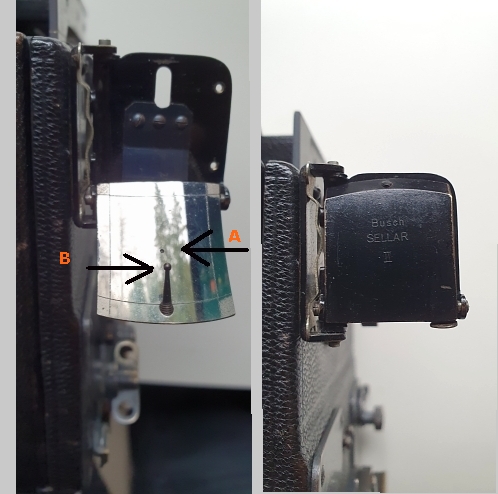Camera #39627 2 1/4 x 3 1/4
The
History
In the year 1914 the Folmer Graflex Company proudly presented " Young Mr. Graflex".
Officially
named "The Auto Graflex Junior"
It was the answer to a fast growing
demand at that time for a small compact camera
but not missing any of the new
features such as mirror reflex, focal plane shutter and above all,
the
reliability of Graflex quality and workmanship combined in a light weight small
sized camera.
The camera body was US $ 35,00.
Equipped with Bauch & Lomb Tessar Series.Ic- US $ 66,00.
To understand
the value of such a camera in nowadays money you must know what was the average
wage in those days.
For example: Henry Ford increased the daily wage of his
workers in 1914 from $2.34 to $5. That $2.34 wage was already high in those
days.
The old saying, "Another day, another dollar," reflects the
circumstances when a dollar a day was a good wage.
So the cost of such an Auto
Graflex Junior was the equivalent of at least one month hard labour.
Short overview of the type of camera.
2
¼ x 3 ½ inch Reflex camera for Plates, Roll Film and Sheet film.
Takes no. 50 Roll Holder
Nicely
designed light box camera made out of mahogany wood covered with black leather.
Brass controls and leather viewing hood.
The overhanging projection at the rear
and the one-piece guide rail holding the bellows and lens standard are
specific details in this beautiful styled design
of a lightweight but very
reliable 2 1/4 x 3 1/4 reflex camera.
The focal plane shutter controlled by the
winding key has four slits and one open as used in all the other Graflex cameras
at that time.
The choice out of 6 different spring tensions provide 24 instant
exposure times, from 1/10 up to 1/1000 of a second and at last the Time
exposure.
 By winding the focal plane
shutter all the way, the last figure appearing in the window next to the winding
key reads 1 ½ which is the smallest and thus fastest exposure speed. This slit
is just 0,5 cm wide. Coupled with the setting of the spring tension it can
provide 6 different exposure speeds. Before winding and thus cocking the
shutter, the mirror should be set. The mirror not only projects the image on the
ground glass but at the same time it serves as a lightbaffle to prevent light
coming into the exposure room. After the mirror has been set in position, the
dark slide of the film holder can be removed and thus prepare the camera for
exposure. Each time when setting the mirror and
pressing the release level the next exposure speed can be set and the shutter be
wound after the mirror has been set again.
By winding the focal plane
shutter all the way, the last figure appearing in the window next to the winding
key reads 1 ½ which is the smallest and thus fastest exposure speed. This slit
is just 0,5 cm wide. Coupled with the setting of the spring tension it can
provide 6 different exposure speeds. Before winding and thus cocking the
shutter, the mirror should be set. The mirror not only projects the image on the
ground glass but at the same time it serves as a lightbaffle to prevent light
coming into the exposure room. After the mirror has been set in position, the
dark slide of the film holder can be removed and thus prepare the camera for
exposure. Each time when setting the mirror and
pressing the release level the next exposure speed can be set and the shutter be
wound after the mirror has been set again.
To set a longer exposure time it is necessary to lower the spring tension. In
this case make sure the mirror stays in reflecting position to prevent unwanted
exposure. In this
case the darks slide of the film holder should be closed. In locked position the
focussing mirror is light obstructing. The curtain can be wound without fogging
the film even when the dark slide of the film holder is pulled out.
Check the operation instructions to learn more about Instant setting as well as Moment exposures of this focal plane shutter.
A
safety device is provided which prevents the winding of the shutter curtain
until the reflecting mirror is depressed, thus preventing the possibility of
fogging the plate or film.
The front is of exceptional rigidity, as the focus racks and front standards are
stamped from one piece of heavy brass.
This insures absolute parallelism of the front and focal plane and also gives
the front a permanent rigidity.
The focusing hood is readily detachable, allowing easy access to the ground
glass focusing screen. The focusing hood is automatic in its action, and is
finished with a square top, making it exceptionally easy to secure vertical
pictures with the camera held on its side.



Camera #37221 Cooke
Anastigmat ƒ 4,5 - 4 inch Serie II # 54730
camera # 39627 Bausch & Lomb Tessar Series 1c #2515612
2 1/2 x 3 1/4
photos © Jo Lommen
The focusing pinion is adjusted though a split washer, which affords sufficient
tension to hold the front at any point when focusing, irrespective of the
position of the camera.
The Auto Graflex Junior is supplied with a depressed cupped shaped metal front
for carrying the lens.
This metal front is threaded to accept the B&L Zeiss
Tessar No. Series Ic lens, Zeiss Kodak Anastigmat No. 1 lens and Cook no. 20
series II (Lens).
The Auto Graflex Junior is fitted with a tripod screw plate in
the bottom of the camera.
The camera can be used with the
antique Graflex roll film holder which takes the 3 ¼ x 2 ¼ No. 50 Eastman
Graflex Film
It is understandable clear that this 1901 patented film is no more available at your
photo shop around the corner and unlikely to find one on the WWW internet.
You may try to overrule this by experimenting with sheet film and matching sheet
film holders.
Finding the 2x3 film holders is not impossible and cutting the still available
3x4 sheet film into 2x3 is easy.
Check here to find some
tips on this.
The Busch
Sellar II
rare waste level viewfinder.

To hold the camera strait up and horizontal while not using
the ground glass, this little device
can help you.
Holding the camera waist level with one eye open and manipulate the camera
position until the dot A on the mirror disappears under the ball B.
Now the camera is 100 % horizontal.
Available No. 50 roll film
holder
Quit easy would be finding a 3
¼ x 2¼ sheet or roll film holder.
The sheet film can be cut by yourself in the desired format out of the
still plenty available 4x5
sheet film.
If you find such a camera that needs some care after 100 year, you may take a look at my page about refurbishing.
To know more about how to operate this delicate camera follow this link.
On this page you'll find the key control functions.

The 5 x 7 inch Auto Graflex Camera
The big one